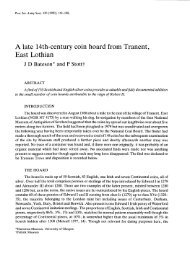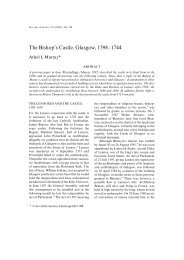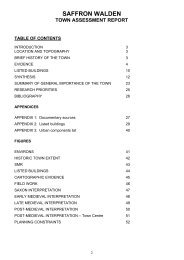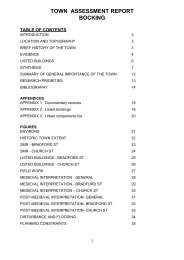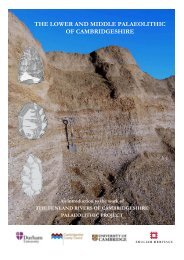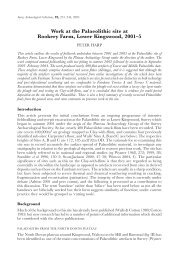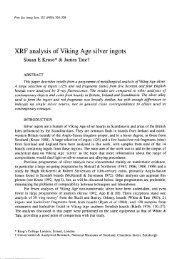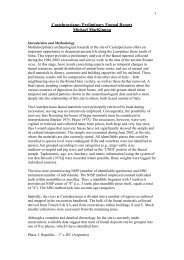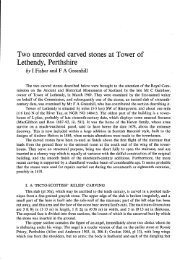Unearthing an air-raid shelter at Edgware Junior School
Unearthing an air-raid shelter at Edgware Junior School
Unearthing an air-raid shelter at Edgware Junior School
You also want an ePaper? Increase the reach of your titles
YUMPU automatically turns print PDFs into web optimized ePapers that Google loves.
<strong>Unearthing</strong> <strong>an</strong> <strong>air</strong>-<strong>raid</strong> <strong>shelter</strong> <strong>at</strong><br />
<strong>Edgware</strong> <strong>Junior</strong> <strong>School</strong><br />
Gabriel Moshenska<br />
Introduction<br />
In the summer of 2005 the edge of a<br />
concrete structure was uncovered on<br />
the playing field of <strong>Edgware</strong> <strong>Junior</strong><br />
<strong>School</strong>. The site was cordoned off, <strong>an</strong>d<br />
the school contacted archaeologists.<br />
Staff <strong>at</strong> the school had been aware for<br />
some time th<strong>at</strong> <strong>air</strong>-<strong>raid</strong> <strong>shelter</strong>s had<br />
been built there during the Second<br />
World War, but their precise loc<strong>at</strong>ion<br />
had remained a mystery. Thus, in a<br />
freezing cold <strong>an</strong>d very wet week in<br />
February 2006, a team of excav<strong>at</strong>ors<br />
from UCL <strong>an</strong>d the Hendon <strong>an</strong>d District<br />
Archaeological Society set out to<br />
unearth one of the <strong>air</strong>-<strong>raid</strong> <strong>shelter</strong> th<strong>at</strong><br />
lay bene<strong>at</strong>h the playing field (Fig. 1).<br />
The project had a number of aims:<br />
the school hoped to use the <strong>shelter</strong> as a<br />
teaching resource for the Second World<br />
War sections of the history curriculum.<br />
For the archaeologists the dig offered a<br />
ch<strong>an</strong>ce to introduce the school children<br />
to the principles <strong>an</strong>d methods of<br />
archaeology, as well as a rare<br />
opportunity to compare the history,<br />
archaeology <strong>an</strong>d living memory of a<br />
site. 1<br />
The site was loc<strong>at</strong>ed <strong>at</strong> <strong>Edgware</strong><br />
<strong>Junior</strong> <strong>School</strong>, Heming Road, <strong>Edgware</strong>;<br />
to the south of <strong>Edgware</strong> underground<br />
st<strong>at</strong>ion <strong>an</strong>d close to W<strong>at</strong>ling Street. The<br />
N<strong>at</strong>ional Grid Reference for the <strong>shelter</strong><br />
in question is TQ 1947 9151; the site<br />
reference is EJS06. The school d<strong>at</strong>es<br />
back to the 1890s; the most recent<br />
block, now the Inf<strong>an</strong>t <strong>School</strong>, was built<br />
in the 1930s.<br />
In the autumn term the Year Six<br />
classes study the Second World War<br />
including work on evacu<strong>at</strong>ion, the Blitz<br />
<strong>an</strong>d visits to the nearby RAF Museum.<br />
While archaeology is not part of the<br />
n<strong>at</strong>ional curriculum, Ancient Egypt <strong>an</strong>d<br />
Greece are popular options, <strong>an</strong>d this<br />
project gave us the opportunity to<br />
integr<strong>at</strong>e archaeology into a curriculum<br />
subject, taking care to emphasise the<br />
Fig. 1: excav<strong>at</strong>ion begins – removing the slabs<br />
of concrete<br />
wide <strong>an</strong>d varied scope of<br />
archaeological work beyond recent<br />
historical sites.<br />
Historical background<br />
The argument for building <strong>air</strong>-<strong>raid</strong><br />
<strong>shelter</strong>s in schools d<strong>at</strong>es back to the<br />
mid-1930s, when local authorities were<br />
encouraged to build public <strong>shelter</strong>s <strong>an</strong>d<br />
make other prepar<strong>at</strong>ions for Civil<br />
Defence. 2 Public fears of aerial<br />
bombing with explosives, gas or<br />
chemical weapons were exacerb<strong>at</strong>ed by<br />
horrific reports from the Itali<strong>an</strong><br />
campaign in Abyssinia <strong>an</strong>d the Germ<strong>an</strong><br />
intervention in the Sp<strong>an</strong>ish Civil War, 3<br />
as well as by St<strong>an</strong>ley Baldwin’s grim<br />
prediction th<strong>at</strong> “the bomber will always<br />
get through” 4<br />
led to the form<strong>at</strong>ion of<br />
the volunteer Air Raid Wardens Service,<br />
<strong>an</strong>d within a year more th<strong>an</strong> 200,000<br />
had joined. The Munich crisis of 1938<br />
following the Germ<strong>an</strong> invasion of<br />
Czechoslovakia led to the mobilis<strong>at</strong>ion<br />
of these volunteers, <strong>an</strong>d more <strong>shelter</strong>s<br />
<strong>an</strong>d trenches beg<strong>an</strong> to be constructed in<br />
parks <strong>an</strong>d playing fields for public use. 5<br />
After the outbreak of war, <strong>Edgware</strong><br />
<strong>School</strong> was closed for a time, <strong>an</strong>d<br />
EDGWARE HISTORICAL AIR-RAID ARCHAEOLOGY<br />
SHELTER<br />
classes were taught in pupils’ homes<br />
<strong>an</strong>d in church halls in the area until<br />
sufficient <strong>shelter</strong>s could be provided <strong>at</strong><br />
the school. 6 In October of 1939<br />
Hendon Borough Council accepted the<br />
tender of Messrs. Lavender, McMill<strong>an</strong><br />
Ltd. of Worcester Park to build <strong>air</strong>-<strong>raid</strong><br />
<strong>shelter</strong>s in schools in the borough. The<br />
council paid £258 17s 10d per <strong>shelter</strong>,<br />
with a £9 16s 0d surcharge for the<br />
minority of <strong>shelter</strong>s which were built of<br />
concrete r<strong>at</strong>her th<strong>an</strong> steel. 7 Work<br />
commenced immedi<strong>at</strong>ely <strong>an</strong>d by the<br />
end of November the first <strong>shelter</strong> <strong>at</strong><br />
<strong>Edgware</strong> <strong>School</strong> was completed, <strong>an</strong>d<br />
classes gradually recommenced. 8 Each<br />
<strong>shelter</strong> had a limited capacity, as the<br />
Board of Educ<strong>at</strong>ion stipul<strong>at</strong>ed th<strong>at</strong> “In<br />
times of d<strong>an</strong>ger children should not be<br />
assembled in groups of more th<strong>an</strong> 50 in<br />
<strong>an</strong>y one protected room”. 9 The records<br />
show th<strong>at</strong> the <strong>shelter</strong>s were fitted with<br />
electric lighting, wooden se<strong>at</strong>ing <strong>an</strong>d<br />
chemical toilets. A year l<strong>at</strong>er he<strong>at</strong>ing,<br />
ventil<strong>at</strong>ion <strong>an</strong>d better lights were<br />
installed so th<strong>at</strong> teaching could<br />
continue in the <strong>shelter</strong>s uninterrupted. 10<br />
The pupils <strong>at</strong> <strong>Edgware</strong> practiced <strong>air</strong><strong>raid</strong><br />
drills <strong>an</strong>d gas mask drills<br />
assiduously, <strong>an</strong>d frequently had to take<br />
SUMMER 2007 London Archaeologist 237
EDGWARE AIR-RAID SHELTER<br />
cover when the sirens sounded in<br />
earnest. The school log reveals the<br />
interruption to the school day caused<br />
by repe<strong>at</strong>ed alerts, some lasting several<br />
hours. In November 1940 the school<br />
was damaged by a bomb l<strong>an</strong>ding<br />
nearby, presumably aimed <strong>at</strong> the<br />
railway terminus to the north. Windows<br />
<strong>an</strong>d roof tiles were sh<strong>at</strong>tered, <strong>an</strong>d<br />
several doors were blown open. Luckily<br />
this was after school hours, so no-one<br />
was injured. Four years l<strong>at</strong>er in October<br />
1944 the school was again nearly hit,<br />
this time by a V1 ‘doodlebug’ flying<br />
bomb which damaged several<br />
classrooms. 11<br />
In 1945, following the end of<br />
hostilities in Europe, the <strong>shelter</strong>s were<br />
no longer needed <strong>an</strong>d the wood, glass<br />
<strong>an</strong>d electrical fittings were stripped out<br />
<strong>an</strong>d sold for scrap. In September 1946<br />
the records show th<strong>at</strong> thirteen <strong>air</strong>-<strong>raid</strong><br />
<strong>shelter</strong>s <strong>at</strong> <strong>Edgware</strong> <strong>School</strong> were sealed<br />
up with reinforced concrete. 12<br />
The historical research opened up a<br />
number of possible questions for the<br />
archaeological work to address. Where<br />
were the thirteen <strong>shelter</strong>s <strong>at</strong> the school<br />
loc<strong>at</strong>ed? Were they constructed of steel<br />
or concrete – <strong>an</strong>d in wh<strong>at</strong> m<strong>an</strong>ner?<br />
Various types of <strong>shelter</strong>s were available<br />
<strong>at</strong> the time, built from prefabric<strong>at</strong>ed<br />
segments or p<strong>an</strong>els, or else cast onsite.<br />
13 How m<strong>an</strong>y fittings such as<br />
benches had remained intact? Are the<br />
structures even stable enough to<br />
excav<strong>at</strong>e <strong>an</strong>d examine? We beg<strong>an</strong> our<br />
evalu<strong>at</strong>ion with all of these questions in<br />
mind.<br />
Fig. 2: resistivity results for the school playing field, with interpret<strong>at</strong>ions<br />
238 London Archaeologist SUMMER 2007<br />
Archaeological work<br />
The first stage of the archaeological<br />
fieldwork was a resistivity survey of the<br />
school playing field. This produced a<br />
promising readout, showing several<br />
clear elong<strong>at</strong>ed rect<strong>an</strong>gular areas of<br />
high resist<strong>an</strong>ce, <strong>an</strong>d a few possible<br />
others (Fig. 2). One of them was clearly<br />
associ<strong>at</strong>ed with the entr<strong>an</strong>ce th<strong>at</strong> had<br />
been found, <strong>an</strong>d on closer inspection it<br />
was possible to make out a raised area<br />
of the field th<strong>at</strong> corresponded to the<br />
readout, made clearer by the white<br />
lines of the football pitch painted over<br />
it. This technique revealed <strong>at</strong> least two<br />
more <strong>shelter</strong>s parallel to the first.<br />
The first <strong>an</strong>d principal area of<br />
excav<strong>at</strong>ion was the clearing out of the<br />
st<strong>air</strong>case, which had been filled to the<br />
top with earth <strong>an</strong>d rubble (Fig. 3). Wary<br />
of the reinforced concrete plug<br />
described in the documents, we had<br />
equipped ourselves with a sledge<br />
hammer <strong>an</strong>d a mighty steel rod. In the<br />
event we found the concrete in<br />
fragments, with no piece larger th<strong>an</strong><br />
about 40 kg, mixed in with the soil. As<br />
the project took place within a school,<br />
our health <strong>an</strong>d safety consider<strong>at</strong>ions<br />
were particularly stringent throughout<br />
the dig.<br />
In addition, a small 2 m by 1 m<br />
trench was opened across the raised<br />
area of turf to examine the exterior of<br />
the <strong>shelter</strong>. This was partly to examine<br />
the w<strong>at</strong>erproofing of the roof, partly to<br />
aid surveying, <strong>an</strong>d also a fallback in<br />
case we were unable to gain access to<br />
the interior of the <strong>shelter</strong>. We found th<strong>at</strong><br />
the <strong>shelter</strong> was only 0.52 m below the<br />
soil, <strong>an</strong>d th<strong>at</strong> the roof had been painted<br />
Fig. 3: clearing the st<strong>air</strong>case<br />
with tar to prevent w<strong>at</strong>er dripping in.<br />
Interestingly, there was no clear<br />
indic<strong>at</strong>ion of the modular construction<br />
th<strong>at</strong> was so obvious from the inside.<br />
This smaller trench produced a number<br />
of interesting finds, including a<br />
halfpenny d<strong>at</strong>ing from 1862, <strong>an</strong>d a<br />
fragment of post-medieval green-glazed<br />
earthenware.<br />
The excav<strong>at</strong>ion of the st<strong>air</strong>case<br />
continued apace, <strong>an</strong>d it became clear<br />
th<strong>at</strong> it was a single piece of concrete,<br />
either cast nearby or delivered as a<br />
preformed unit. A casting mark running<br />
<strong>at</strong> <strong>an</strong> <strong>an</strong>gle of about 20° made it<br />
unlikely th<strong>at</strong> it was cast in place. Tree<br />
roots had shifted the st<strong>air</strong>case slightly,<br />
so it was no longer exactly in alignment<br />
with the <strong>shelter</strong>. Two of the visible<br />
walls of the <strong>shelter</strong> were observed to be<br />
built from preformed p<strong>an</strong>els of<br />
reinforced concrete approxim<strong>at</strong>ely
Fig. 4: lamp or he<strong>at</strong>er buried inside the <strong>shelter</strong><br />
0.45 m wide <strong>an</strong>d 2 m high, while the<br />
partition to the right of the entr<strong>an</strong>ce was<br />
a half-brick wall.<br />
Finally, when enough of the soil<br />
<strong>an</strong>d loose rubble had been removed<br />
<strong>an</strong>d the structure deemed stable <strong>an</strong>d<br />
safe, we were able to make our first<br />
tent<strong>at</strong>ive steps through the open<br />
doorway of the <strong>shelter</strong>. This was the<br />
Howard Carter moment we had been<br />
<strong>an</strong>ticip<strong>at</strong>ing: having cleared the<br />
entr<strong>an</strong>ce st<strong>air</strong>s, to hold a lamp up to the<br />
darkness within <strong>an</strong>d <strong>an</strong>nounce th<strong>at</strong> we<br />
could see “Things! Wonderful things!”.<br />
The first impression was of size: the<br />
<strong>shelter</strong> felt longer below ground th<strong>an</strong> it<br />
had appeared in outline on the surface;<br />
it was almost 15 m long. The ceiling<br />
was covered in condens<strong>at</strong>ion <strong>an</strong>d the<br />
floor was wet <strong>an</strong>d slimy. Despite our<br />
hope for wonderful things, the <strong>shelter</strong><br />
was r<strong>at</strong>her bare: the benches had been<br />
removed, as had the chemical toilets<br />
(mercifully, I think). The two toilet<br />
cubicles remained, one <strong>at</strong> each end. At<br />
the far end there was a metal ladder<br />
leading up to <strong>an</strong> emergency exit, sealed<br />
with a concrete plug. 14 A qu<strong>an</strong>tity of<br />
scrap metal, builders’ rubble <strong>an</strong>d other<br />
rubbish had been piled below this,<br />
presumably thrown down. However,<br />
there were several remn<strong>an</strong>ts of the<br />
original contents: a fire bucket with<br />
flakes of red paint remaining, a<br />
hurric<strong>an</strong>e lamp <strong>an</strong>d <strong>an</strong> inkwell hidden<br />
in the corner. Some fragments of the<br />
electrical wiring remained, including<br />
the brackets for the distribution p<strong>an</strong>el<br />
<strong>an</strong>d several bakelite covers. A large,<br />
freest<strong>an</strong>ding gas lamp/he<strong>at</strong>er was found<br />
buried <strong>at</strong> the bottom of steps <strong>an</strong>d<br />
painstakingly excav<strong>at</strong>ed (Fig. 4).<br />
We had hoped to find graffiti on the<br />
walls, perhaps including the names of<br />
children who had <strong>shelter</strong>ed there. In the<br />
event only one was found, a r<strong>at</strong>her<br />
whimsical rendition of a sailing ship in<br />
yellow chalk, with a cross on the sail<br />
(Fig. 5). The toilet partition wall <strong>at</strong> the<br />
far end of the <strong>shelter</strong> revealed a whole<br />
series of m<strong>at</strong>hs problems chalked on<br />
the bricks, presumably the remains of a<br />
lesson me<strong>an</strong>t for the children to copy<br />
down. The freshness <strong>an</strong>d preserv<strong>at</strong>ion<br />
of these ephemeral marks on the wall<br />
was remarkable, <strong>an</strong>d it is hoped th<strong>at</strong><br />
they c<strong>an</strong> be preserved. The <strong>shelter</strong> has<br />
been surveyed <strong>an</strong>d recorded in detail,<br />
although the detailed examin<strong>at</strong>ion of<br />
the interior for graffiti <strong>an</strong>d other fe<strong>at</strong>ures<br />
c<strong>an</strong> be <strong>an</strong> ongoing process, as the<br />
<strong>shelter</strong> is being kept open <strong>an</strong>d<br />
accessible for the time being.<br />
Remembering the <strong>shelter</strong>s<br />
Shortly after we completed the<br />
geophysical survey, I had placed <strong>an</strong><br />
appeal in the local paper for <strong>an</strong>yone<br />
who <strong>at</strong>tended the school during the war<br />
to contact me <strong>an</strong>d pay a visit to the site.<br />
By the start of the excav<strong>at</strong>ion we had<br />
received one reply, <strong>an</strong>d so Mrs Tessa<br />
Smith visited the school on the second<br />
day of the excav<strong>at</strong>ion (Fig 6). From the<br />
archaeological perspective, one of the<br />
most interesting things she told us was<br />
Fig. 5: graffito of a sailing ship chalked on the wall<br />
EDGWARE AIR-RAID SHELTER<br />
th<strong>at</strong> the <strong>shelter</strong>s she had used, as well<br />
as two or three others, were under <strong>an</strong><br />
area of the playground now under<br />
tarmac th<strong>at</strong> we had not considered in<br />
our initial survey as we could not use a<br />
resistivity meter on it. This revel<strong>at</strong>ion<br />
made a total of thirteen <strong>shelter</strong>s seem<br />
much more feasible. She described<br />
rows of children packed so close th<strong>at</strong><br />
their knees were touching, suggesting<br />
th<strong>at</strong> there may have been three rows of<br />
benches in the larger <strong>shelter</strong>s r<strong>at</strong>her<br />
th<strong>an</strong> just one against each wall as we<br />
had assumed.<br />
Mrs Smith described going into the<br />
<strong>shelter</strong>s: walking briskly out of the<br />
classrooms <strong>an</strong>d across the field (but<br />
running), taking a pencil <strong>an</strong>d notebook<br />
as well as a reading book. In the<br />
<strong>shelter</strong>s work, games <strong>an</strong>d songs passed<br />
the time until the all-clear was sounded:<br />
“We ch<strong>an</strong>ted our tables, we did our<br />
spellings, we played h<strong>an</strong>gm<strong>an</strong> … we<br />
took books to read <strong>an</strong>d we s<strong>an</strong>g<br />
p<strong>at</strong>riotic songs, so we could have filled<br />
<strong>an</strong> hour reasonably cheerfully”. The<br />
smell of the <strong>shelter</strong> was particularly<br />
evoc<strong>at</strong>ive: “It wasn’t <strong>an</strong> unpleas<strong>an</strong>t<br />
smell, but it was a cementy, s<strong>an</strong>d-baggy<br />
smell – if you know wh<strong>at</strong> a s<strong>an</strong>dbag<br />
smells like – a musty smell as you went<br />
in.” 15 In total I recorded over <strong>an</strong> hour of<br />
interviews with Mrs Smith. Since the dig<br />
several other former pupils have been<br />
in contact, <strong>an</strong>d further visits to the<br />
school are being arr<strong>an</strong>ged.<br />
SUMMER 2007 London Archaeologist 239
EDGWARE AIR-RAID SHELTER<br />
Fig. 6: Mrs Smith telling curious students about the school in wartime<br />
Mrs Smith also spoke to a Year Six<br />
class who had studied the Second<br />
World War, telling them about her early<br />
years living in the area, <strong>an</strong>d about the<br />
experiences of a wartime childhood.<br />
She <strong>an</strong>swered their questions on the<br />
<strong>shelter</strong>s, on her school days <strong>an</strong>d on the<br />
war in general. The enthusiasm <strong>an</strong>d<br />
curiosity of the children was<br />
remarkable, <strong>an</strong>d this was reflected in<br />
the questions they asked, often drawing<br />
on things they had learnt in class or<br />
heard from elderly rel<strong>at</strong>ives who had<br />
lived through the war. Overall Mrs<br />
Smith’s visit was of gre<strong>at</strong> value from<br />
both <strong>an</strong> interpretive perspective <strong>an</strong>d <strong>an</strong><br />
educ<strong>at</strong>ional one, for the archaeologists<br />
<strong>an</strong>d the school children, adding real-life<br />
colour to the stark concrete structure<br />
we had revealed.<br />
Educ<strong>at</strong>ion<br />
During the excav<strong>at</strong>ions, each class in<br />
the school was brought over to the dig<br />
by their teachers to observe (from a safe<br />
dist<strong>an</strong>ce), <strong>an</strong>d to be shown the artefacts<br />
we were uncovering. We described<br />
wh<strong>at</strong> the <strong>shelter</strong> was <strong>an</strong>d why it was<br />
1. As recommended by the CBA research agenda for<br />
civil defence sites: see J. Schofield (ed) Modern military<br />
m<strong>at</strong>ters: studying <strong>an</strong>d m<strong>an</strong>aging the twentieth century<br />
defence heritage in Britain: a discussion document (2004)<br />
45–6. York: CBA.<br />
2. T. O’Brien Civil defence (1955) London: HMSO.<br />
3. C.S. Dobinson Civil defence in WWII: protecting<br />
Engl<strong>an</strong>d’s civil popul<strong>at</strong>ion 1935-45. (2000) York: CBA<br />
4. S. Lindqvist A history of bombing. (2002) London:<br />
Gr<strong>an</strong>ta.<br />
5. T. O’Brien Civil defence. (1955) London: HMSO.<br />
240 London Archaeologist SUMMER 2007<br />
built, <strong>an</strong>d how we were finding out<br />
about it from the excav<strong>at</strong>ions. We<br />
pointed out the earthworks visible on<br />
the surface, <strong>an</strong>d explained how we<br />
used geophysics to see under the<br />
ground.<br />
Towards the end of the week Sarah<br />
Dh<strong>an</strong>jal <strong>an</strong>d Jenny Stripe from the<br />
Institute of Archaeology Widening<br />
Particip<strong>at</strong>ion Team gave a present<strong>at</strong>ion<br />
to the entire school on<br />
explaining why we dig<br />
under the ground to find things th<strong>at</strong> tell<br />
us about people’s lives in the past. This<br />
assembly helped lay the found<strong>at</strong>ion for<br />
further archaeological work <strong>at</strong> the<br />
school, which will mainly focus on<br />
processing <strong>an</strong>d studying the artefacts<br />
recovered from the excav<strong>at</strong>ion, <strong>an</strong>d<br />
fitting them into the ch<strong>an</strong>ging story of<br />
the site over time. We are also pl<strong>an</strong>ning<br />
to involve the children in further oral<br />
history interviewing of local residents<br />
who <strong>at</strong>tended the school during the<br />
war, to build up a more complete story<br />
of the school <strong>an</strong>d its <strong>air</strong>-<strong>raid</strong> <strong>shelter</strong>s in<br />
the war.<br />
6. <strong>Edgware</strong> <strong>School</strong> Logbook, 29th November 1939.<br />
7. Hendon Educ<strong>at</strong>ion Committee Minutes, 3rd<br />
October 1939.<br />
8. <strong>Edgware</strong> <strong>School</strong> Logbook, 29th November 1939.<br />
9. Board of Educ<strong>at</strong>ion Circular 1467, 27th April 1939.<br />
HMSO.<br />
10. Hendon Educ<strong>at</strong>ion Committee Minutes, 8th March<br />
1941.<br />
11. <strong>Edgware</strong> <strong>School</strong> Logbook, 18th November 1940;<br />
6th October 1944.<br />
Conclusions <strong>an</strong>d after<br />
The <strong>air</strong>-<strong>raid</strong> <strong>shelter</strong> excav<strong>at</strong>ion was a<br />
valuable <strong>an</strong>d rewarding exercise in<br />
combining history, archaeology <strong>an</strong>d<br />
memory in the examin<strong>at</strong>ion of a site.<br />
The loc<strong>at</strong>ion within a school allowed us<br />
to begin to integr<strong>at</strong>e our work into the<br />
teaching <strong>an</strong>d learning of history, <strong>an</strong>d<br />
encouraged us to explain <strong>an</strong>d justify our<br />
methods as tr<strong>an</strong>sparently as possible.<br />
Perhaps the best measure of our success<br />
is th<strong>at</strong> despite seeing us slaving away<br />
covered in mud through rain, hail <strong>an</strong>d<br />
snow, several children <strong>an</strong>nounced to us<br />
th<strong>at</strong> they w<strong>an</strong>ted to be archaeologists<br />
when they grow up.<br />
Wh<strong>at</strong> next for the <strong>air</strong>-<strong>raid</strong> <strong>shelter</strong>?<br />
The school hopes to turn it into a mini<br />
museum, to be used by the Year Six<br />
children learning about the Second<br />
World War. To do so, the <strong>shelter</strong>s will<br />
need numerous expensive<br />
modific<strong>at</strong>ions to comply with building<br />
<strong>an</strong>d safety regul<strong>at</strong>ions. If the money c<strong>an</strong><br />
be found in gr<strong>an</strong>ts <strong>an</strong>d sponsorship, this<br />
will be a f<strong>an</strong>tastic resource th<strong>at</strong> c<strong>an</strong><br />
benefit other schools in the area as well<br />
as the wider community.<br />
Acknowledgements<br />
This project was made possible by the<br />
generous support in time <strong>an</strong>d<br />
equipment from the Hendon <strong>an</strong>d<br />
District Archaeological Society. M<strong>an</strong>y,<br />
m<strong>an</strong>y th<strong>an</strong>ks to all the diggers who<br />
braved the elements: Andy Ag<strong>at</strong>e, Jamie<br />
Connolly, Don Cooper, Andrew<br />
Coulson, Sarah Dh<strong>an</strong>jal, Jack Feintuck,<br />
Holly Holm<strong>an</strong>, Sus<strong>an</strong> Holmes, Morag<br />
McBride, Jim Nelhams <strong>an</strong>d Jenny Stripe.<br />
At <strong>Edgware</strong> <strong>Junior</strong> <strong>School</strong> I am hugely<br />
gr<strong>at</strong>eful to Sue Renowden, the instig<strong>at</strong>or<br />
<strong>an</strong>d driving force of the project, <strong>an</strong>d to<br />
Peter Truem<strong>an</strong> whose practical<br />
assist<strong>an</strong>ce was invaluable. Th<strong>an</strong>ks also<br />
to Kim Stabler <strong>at</strong> English Heritage,<br />
Yasmine Webb <strong>at</strong> the Barnet Archives<br />
<strong>an</strong>d the librari<strong>an</strong>s <strong>at</strong> the Imperial War<br />
Museum. This project forms part of<br />
research funded by the Arts <strong>an</strong>d<br />
Hum<strong>an</strong>ities Research Council.<br />
12. Hendon Educ<strong>at</strong>ion Committee Minutes, 10th<br />
September 1946.<br />
13. D.H. Lee Design <strong>an</strong>d construction of <strong>air</strong> <strong>raid</strong> <strong>shelter</strong>s<br />
in accord<strong>an</strong>ce with the civil defence act, 1939, <strong>an</strong>d for<br />
unspecified areas <strong>an</strong>d other purposes. (1940) London:<br />
Concrete Public<strong>at</strong>ions Ltd.<br />
14. For <strong>an</strong> isometric pl<strong>an</strong> of such a <strong>shelter</strong> see B.<br />
Lowry (ed) 20th Century defences in Britain: <strong>an</strong><br />
introductory guide (1996) 68. York: CBA.<br />
15. Interview with Mrs Tessa Smith, 21.2.06.







